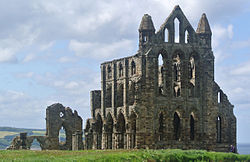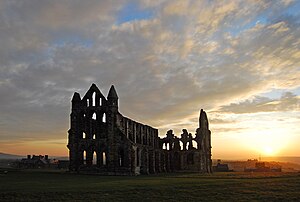Whitby Abbey
| Whitby Abbey | |
|
Yorkshire | |
|---|---|

| |
| Location | |
| Location: | 54°29’18"N, -0°36’27"W |
| Main town: | Whitby |
| Order: | Benedictine |
| History | |
| Established: | 657AD |
| Mother house: | Fountains Abbey |
| Founder: | 1.Oswy, 2.Prior Reinfrid |
| Information | |
| Condition: | substantial ruins |
| Owned by: | English Heritage |
Whitby Abbey is a ruined Benedictine abbey overlooking the North Sea on the East Cliff above Whitby in the North Riding of Yorkshire. Once one of the greatest, and oldest, of the monasteries in the land, it was disestablished during the Dissolution of the Monasteries under the auspices of Henry VIII and its buildings fell into ruin.
Today the broken abbey stands bleak against the sky overlooking the sea, on the cliffs where the Cleveland Hills fall into the North Sea.
The abbey is a Grade I Listed building in the care of English Heritage. The site museum is housed in Cholmley House.
Streoneshalh
The first monastery was founded in the Anglo-Saxon era, in the year 657 by Oswy, King of the Northumbrians, in which age the village and abbey were known as Streoneshalh.[1] King Oswy appointed as the first abbess and leader of the community Lady Hilda, abbess of Hartlepool Abbey and grand-niece of King Edwin the first Christian king of Northumbria.
The name Streoneshalh is thought to signify Fort Bay or Tower Bay in reference to a supposed Roman settlement that previously existed on the site. This contention has never been proven though and alternative theories have been proposed.
The double monastery of Celtic monks and nuns was home to the great Northumbrian poet Cædmon.
In 664 the Synod of Whitby was held in the Abbey. At this synod, after much heated debate, King Oswy ruled that the Northumbrian church would adopt the Roman practices and authority in place of Irish practices, including the Roman calculation of Easter and monastic tonsure.
Streoneshalch was laid waste by Danes in successive raids between 867 and 870 under |Ingwar ("Ivar the Boneless") and Ubba and remained desolate for more than 200 years. The existence of 'Prestebi', meaning the habitation of priests in Old Norse, at the Domesday Survey may point to the revival of religious life since Danish times.[2] The old monastery given to Reinfrid comprised about 40 ruined monasteria vel oratoria similar to Irish monastic ruins with numerous chapels and cells.[3]
Whitby

By the Norman era, the village was known as Hwitebi or as Prestebi; names from the Old Norse language ("White village" and "Priest village" respectively). The former survives as today's name for the town, Whitby. Reinfrid, a soldier of William the Conqueror, became a monk and travelled to Whitby. He approached William de Percy who gave him the ruined monastery of St Peter with two carucates of land, to found a new monastery. Serlo de Percy, the founder's brother, joined Reinfrid at the new monastery which followed the Benedictine rule.[3]
The first prior, Reinfrid, ruled for many years before being killed in an accident. He was buried at St Peter at Hackness. He was succeeded as prior by Serlo de Percy.[3]
This second monastery lasted until it was destroyed by Henry VIII in 1540 during the Dissolution of the Monasteries. Though the abbey fell into ruin, it remained a prominent landmark for sailors and helped inspire Bram Stoker's Dracula.[4] The ruins are now owned and maintained by English Heritage.
In December 1914, Whitby Abbey was shelled by the German battlecruisers Von der Tann and Derfflinger, which were aiming for the signal post on the end of the headland. Scarborough and Hartlepool were also attacked. The Abbey sustained considerable damage during the ten minute attack. The BBC included before and after photographs as part of the First World War centenary.[5]
Dracula

Whitby Abbey was rendered famous in fiction by Bram Stoker's 1897 novel Dracula. The author was familiar with the town and the atmospheric view of the shattered abbey on the cliff. In the book, Dracula comes ashore here as a creature resembling a large dog and proceeds to climb the 199 steps which lead up to the ruins.
A Gothic festival is held every year in Whitby, inspired by the Dracula connection.
Abbey possessions
The original gift of William de Percy not only included the monastery of St Peter at Streoneshalch, but the town and port of Whitby with its parish church of St. Mary and six dependent chapels at Fyling, Hawsker, Sneaton, Ugglebarnby, Dunsley, and Aislaby, five mills including Ruswarp, the town of Hackness with two mills and the parish church of St. Mary, and the church of St. Peter at Hackness 'where our monks served God, died, and were buried,' and various other gifts enumerated in the ' Memorial' in the abbot's book.[3]
Notable burials
- Oswiu of Northumbria, a King of Bernicia
- Edwin of Deira, King of Deira and Bernicia, later sainted
- Eahlfrith, Oswiu's widow and an Abbess of Whitby
- Ælfflæd of Whitby, daughter of Oswiu and Eanflæd, also an Abbess of Whitby
- Sir William de Percy, 1st Baron Percy (d.c. 1096), Norman baron and Crusader
- Sir Richard de Percy, 5th Baron Percy (1166-1243), signatory to Magna Carta
Outside links
| ("Wikimedia Commons" has material about Whitby Abbey) |
- Whitby Abbey - English Heritage
References
- ↑ Higham, N. J. (2006). (Re-)Reading Bede: The Ecclesiastical History in context. Abingdon: Routledge. p. 46. ISBN 0-415-35368-8.
- ↑ Parishes: Whitby – A History of the County of York: North Riding - Volume : {{{2}}} (Victoria County History)
- ↑ 3.0 3.1 3.2 3.3 Abbey of Whitby – A History of the County of York: North Riding - Volume : {{{2}}} (Victoria County History)
- ↑ Whitby Abbey – English Heritage
- ↑ "How Stonehenge site became the world's largest military training camp". BBC news. 6 November 2014. http://www.bbc.co.uk/news/magazine-29894516. Retrieved 18 November 2014.
